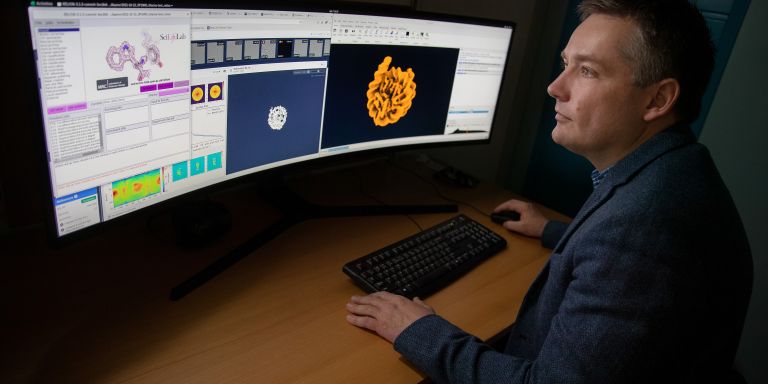
Sebastian Deindl
Professor of Molecular Biophysics
Wallenberg Academy Fellow, prolongation grant 2019
Institution:
Uppsala University
Research field:
Cellular protein machines


Wallenberg Academy Fellow, prolongation grant 2019
Institution:
Uppsala University
Research field:
Cellular protein machines
Every human cell contains a copy of our entire DNA, tightly packed in our chromosomes. If the whole DNA double helix were to be unwound, the result would be a strand several meters long from each cell nucleus. Nature has evolved an ingenious method of packaging the DNA into the cell nucleus, which measures a mere six micrometers.
The DNA must be stored as efficiently as possible, and not only that – it must be easily accessible when the cell needs to read individual genes. Part of the solution is first to tightly wrap the strands around cylindrical structures to form nucleosomes, which are then packed tightly together into higher-order chromatin structures and chromosomes.
Nucleosomes consist of eight spherical proteins called histones. For a long time it was thought that histones’ sole function was as packaging material. But in the 1990s scientists discovered that they also played a central role in gene regulation.
Minute but very intricate protein machines constantly change the packaging state of the DNA by altering the position and composition of nucleosomes. This ensure that the right genes can be read at the right time.
“If this goes wrong, very serious diseases can strike the cell, such as cancer. Our goal is to find out how the protein machines work by lifting the hood of their engines,” Deindl says.
The approach is very much a multidisciplinary one, and Deindl’s research team possesses a broad range of skills.
“By using multiple methods we’re able to approach fundamental research questions from different angles. It’s a true team effort, in which everyone contributes, as is reflected in the number of authors listed for the articles we publish.”
“The Wallenberg Academy Fellow scheme gives you the freedom to delve into complicated problems without being afraid of failure. On the contrary – failure is a necessary part of progress.”
The team’s expertise spans everything from traditional biochemistry, computational approaches, structural biology and new advanced imaging methods. Two types of microscopy are particularly important for Deindl´s mechanistic studies. Cryo-electron microscopy is one; it is used to obtain the protein machines’ three-dimensional structures. The other technique is called single-molecule FRET (Fluorescence Resonance Energy Transfer). This method does not provide images in the traditional sense; it shows the dynamics of changes in distances between different parts of an individual protein machine. Simply put, cryo-electron microscopy reveals the various different shapes of a protein machine, and single-molecule FRET provides information on the dynamics with these shapes interconvert.
“Single-molecule FRET enables us to see the dynamics of individual molecules in real time, and, together with structural information, we can get one step closer to recording ‘molecular movies’ of protein machines in action.”
Movement is detected by interpreting changes in the intensities of fluorescence emission from donor and acceptor fluorophores caused by energy transfer between them when they are placed at strategically chosen points in a protein. Standard FRET microscopes use two colors, but Deindl’s team has built the only one in Sweden using more than two colors.
“We want to understand the mechanisms underlying the operation of protein machines that change the placement and composition of nucleosomes. More colors give more detailed information because more than one distance can be monitored in real time. But each experiment must be designed very carefully to be able to obtain the desired information.”
Deindl likens building single-molecule microscopes to using a giant Lego set for grown-ups.
“The instruments we build look like giant Lego models, in which the parts consist of various lenses and electronics. The more advanced the tools we build, the more detailed our interrogation of nature becomes.”
Even as a child he wanted to understand how the world around him worked. At home in his basement he alternated between technological experiments and chemical ones, often to his parents’ horror. He has not lost his sense of playfulness, although his role as research leader does carry important responsibilities.
“Trying to understand how nature works is a fascinating task. Even to scratch the surface of how these protein machines work would be a fantastic achievement.”
That understanding may pave the way for new drugs aimed at correcting errors in DNA processing. Working together with a research team at the Francis Crick Institute in London, England, Deindl’s group has identified one of the protein machines as a promising drug candidate.
“We are researchers focused on basic science, and our task is to add to knowledge in our field. But combined with findings by other research teams, our work may open up new perspectives for therapeutic intervention strategies,” Deindl says.
He describes the work as highly creative, where one must be allowed to take risks and sometimes fail.
“The Wallenberg Academy Fellow concept is a great help to us, as it encourages a large measure of risk-taking. The funding has made it easier to put together a good team, where the ability of individuals to take the initiative is a key feature.”
For his own part, Deindl practices delegating as much of the routine work as possible. Back home his partner is currently on parental leave with their second child.
“I love the freedom in the work we do – it’s an enormous privilege. My next goal is to focus on a few things that are of perhaps even greater importance, and to do them well,” he concludes.
Text Magnus Trogen Pahlén
Translation Maxwell Arding
Photo Magnus Bergström